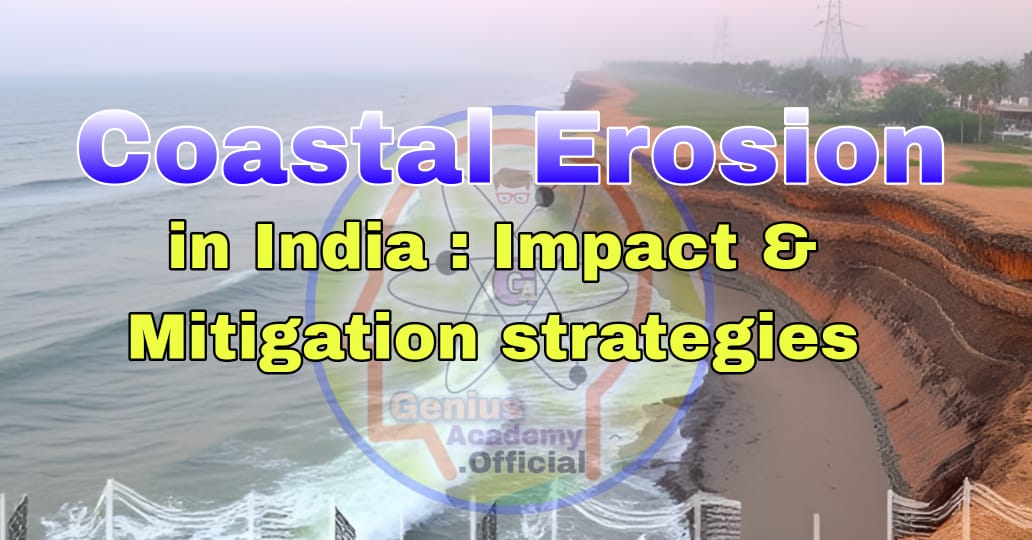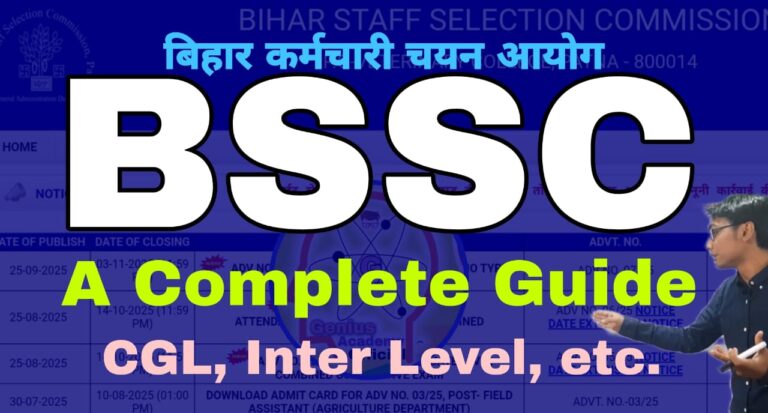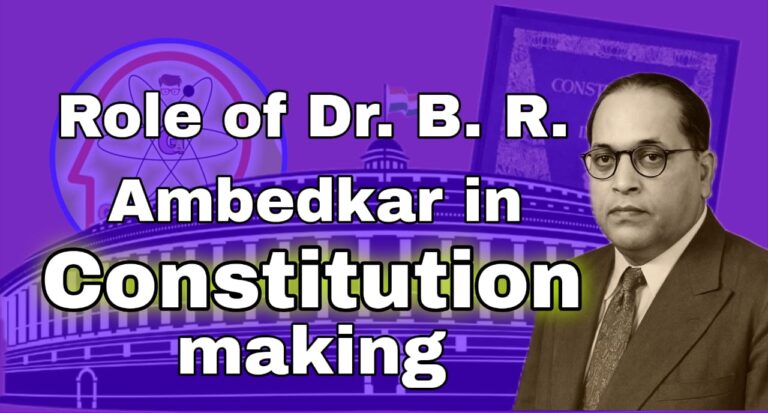Comprehensive Analysis of Coastal Erosion in India: Causes, Impacts, and Mitigation Strategies
Introduction
India, with its extensive coastline spanning over 7,500 kilometers, faces a critical environmental challenge in the form of coastal erosion. According to data presented by the Union Environment Ministry in the Lok Sabha, nearly 33.6% of India’s coastline is vulnerable to erosion, which poses significant risks to human settlements, ecosystems, and infrastructure. This issue demands immediate attention and a comprehensive approach that includes scientific research, sustainable development, and community participation.
This document explores the multifaceted problem of coastal erosion, examining its causes, impacts, affected regions, and the various mitigation measures undertaken by the government and other stakeholders.
India’s Coastal Morphology
The Indian mainland coast covers 9 coastal states and 2 Union Territories (UTs), consisting of 66 coastal districts. The coastline is diverse in its morphology, which includes:
- Sandy Beaches: 43%
- Rocky Coasts: 11%
- Muddy Flats: 36%
- Marshy Coasts: 10%
- Estuaries: 97 major estuaries
- Lagoons: 34 lagoons
This geographical diversity makes the Indian coastline vulnerable to different forms of erosion depending on local conditions.
Extent of Coastal Erosion in India
Based on the findings of the National Centre for Coastal Research (NCCR), the current status of India’s coastline is as follows:
- 33.6% of the coastline is experiencing erosion.
- 26.9% of the coastline is undergoing accretion (growth).
- 39.6% of the coastline remains stable.
This data reflects the need for targeted strategies in regions where erosion poses a significant threat.
States Prone to Coastal Erosion
1. Karnataka
The recent Lok Sabha session highlighted the plight of Dakshina Kannada district, where:
- 48.4% of the 36.66 km coastline has eroded over the past three decades.
- The erosion in Dakshina Kannada is a microcosm of the larger national issue.
Other regions in Karnataka affected by erosion include:
- Udupi District: 34.7% of the 100.71 km coastline.
- Uttara Kannada District: 12.3% of the 175.65 km coastline.
2. West Bengal
- Approximately 60.5% of West Bengal’s coastline is eroding, with severe impacts on the Sundarbans delta, which is a UNESCO World Heritage Site.
3. Kerala
- 46.4% of Kerala’s coastline faces erosion. This erosion has critical implications for local communities, infrastructure, and biodiversity.
4. Tamil Nadu
- 42.7% of Tamil Nadu’s coastline is eroding, threatening coastal infrastructure and the livelihoods of fishing communities.
These statistics emphasize the widespread nature of coastal erosion and the need for region-specific interventions.
Causes of Coastal Erosion
Natural Factors
1. Wave Action:
- Continuous wave action during high tides and storms wears away the shoreline, particularly on sandy beaches.
2. Sea-Level Rise:
- Climate change has led to rising sea levels, which increase the frequency and intensity of coastal flooding and erosion.
3. Storm Surges:
- Cyclones and storm surges, particularly in low-lying areas, accelerate erosion and cause significant land loss.
4. Tectonic Activity:
- Geological processes, such as land subsidence and seismic activities, can alter coastal dynamics and contribute to erosion.
Anthropogenic (Human-Induced) Factors
1. Coastal Development:
- The construction of ports, harbors, seawalls, and breakwaters interferes with the natural movement of sand and sediments, exacerbating erosion.
2. Sand Mining:
- Illegal and excessive sand mining from beaches and riverbeds reduces the natural replenishment of coastal sands, leading to erosion.
3. Deforestation and Mangrove Depletion:
- The destruction of mangroves and coastal vegetation removes natural barriers that protect the coast from wave action and storm surges.
4. Infrastructure Projects:
- Development activities close to the shoreline often disrupt sediment flow and destabilize coastal regions.
Impacts of Coastal Erosion
1. Loss of Land
- Erosion leads to the permanent loss of agricultural land, residential areas, and commercial zones, reducing available resources and economic productivity.
2. Displacement of Communities
- Coastal communities, particularly fishing villages, are forced to relocate due to land loss, resulting in socio-economic challenges and increased vulnerability.
3. Damage to Infrastructure
- Infrastructure such as roads, bridges, ports, and buildings near the coast are at risk of collapse or damage, leading to high repair costs and economic disruption.
4. Biodiversity Loss
- Coastal habitats like mangroves, coral reefs, and wetlands are degraded, leading to a decline in marine biodiversity and the collapse of fragile ecosystems.
5. Economic Impacts
- Industries dependent on coastal stability, such as fishing, tourism, and agriculture, suffer losses due to erosion, affecting millions of livelihoods.
6. Increased Vulnerability to Natural Disasters
- Erosion increases vulnerability to cyclones, tsunamis, and storm surges, amplifying the risks faced by coastal populations.
Government Initiatives and Mitigation Measures
1. Integrated Coastal Zone Management Project (ICZMP)
- Scope: Implemented in Gujarat, Odisha, and West Bengal with World Bank assistance.
- Objective: Protect and conserve coastal and marine environments through sustainable practices.
- Components: Afforestation, conservation of biodiversity, pollution control, and livelihood security.
2. Coastal Regulation Zone (CRZ) Notification, 2019
Purpose:
- Conserve and protect coastal stretches.
- Ensure livelihood security for fisher and local communities.
- Permit regulated development and erosion control measures.
Features:
- No Development Zones (NDZ): Restrictions on construction in ecologically sensitive areas to prevent erosion.
- Shoreline Protection Measures: Guidelines for constructing protective structures.
3. Coastal Vulnerability Index (CVI)
- Developed by: Indian National Centre for Ocean Information Services (INCOIS).
- Purpose: Assess and map the vulnerability of different coastal regions based on factors like sea-level rise, shoreline changes, and socio-economic data.
4. Multi-Hazard Vulnerability Maps
- Prepared by: INCOIS
- Features: Identify areas vulnerable to coastal hazards like cyclones, tsunamis, and storm surges using high-resolution data and terrain mapping.
Innovative Engineering Solutions
1. Artificial Reefs
- Function: Dissipate wave energy, reduce erosion, and promote marine biodiversity.
- Example: Deployed in various regions to stabilize shorelines and protect ecosystems.
2. Eco-Friendly Breakwaters
- Description: Structures made from environmentally compatible materials.
- Benefit: Provide effective shoreline protection without harming marine life.
3. Geo-Tube Installation
- Application: Successfully implemented in Pentha Village, Odisha.
- Function: Create artificial barriers to protect against erosion and storm surges.
4. Mangrove and Shelterbelt Plantations
Benefits:
- Mangroves act as natural buffers against wave action.
- Shelterbelts of trees stabilize the shoreline and reduce the impact of cyclones.
Community Involvement and Awareness
1. Community-Driven Conservation
- Encouraging local communities to participate in conservation efforts ensures that traditional knowledge and practices are integrated with modern solutions.
- Examples: Village-level committees and cooperatives managing mangrove plantations.
2. Education and Awareness Campaigns
- Objective: Raise awareness about the importance of coastal ecosystems and the impacts of erosion.
- Methods: Workshops, media campaigns, and educational programs for school children and fisher communities.
Case Study: Karnataka’s Response to Coastal Erosion
1. Shoreline Management Plan
- Developed under the Coastal Regulation Zone (CRZ) Notification, 2019.
- Focuses on sustainable development and protection of vulnerable coastal areas.
2. Karnataka Strengthening Coastal Resilience and the Economy (K-SHORE) Project
- Funding: World Bank
Objectives:
- Strengthen coastal protection measures.
- Enhance resilience against natural disasters.
- Address marine plastic pollution.
3. Challenges Faced
- Political Interference: Recommendations to avoid habitation in vulnerable areas are often ignored due to political considerations.
- Infrastructure Limitations: Despite spending over ₹200 crore in the past 25 years, traditional methods like seawalls have proven ineffective.
4. Expert Recommendations
- Marine Geologists: Emphasize the importance of maintaining natural processes and avoiding structures that interfere with sediment flow.
- Engineers: Advocate for creating safe townships away from vulnerable zones to protect residents during monsoons.
Future Directions
1. Holistic Coastal Management
- Adopt Integrated Coastal Zone Management (ICZM) principles to balance ecological preservation, development, and disaster resilience.
2. Scientific Research and Innovation
- Enhance collaboration with research bodies like NCCR and INCOIS to develop data-driven strategies.
- Invest in real-time monitoring systems using AI and GIS to predict and manage erosion patterns.
3. Sustainable Development Policies
- Update CRZ regulations to reflect the latest scientific findings and global best practices.
- Ensure enforcement of laws against illegal sand mining and encroachments.
4. Community Resilience Programs
- Focus on building resilient livelihoods through skill development, alternative employment, and disaster preparedness training.
5. International Collaboration
- Learn from successful global examples like the Netherlands’ Delta Works and adopt best practices in coastal engineering and management.
Conclusion of Coastal Erosion in India
Coastal erosion in India is a complex challenge that requires a multi-faceted and coordinated approach. By integrating scientific research, innovative engineering solutions, sustainable development policies, and community involvement, India can mitigate the impacts of erosion. Protecting the coastline is not only crucial for preserving the environment but also for ensuring the livelihoods and safety of millions of coastal residents. Effective and forward-thinking strategies will safeguard India’s rich coastal heritage and ensure a resilient and sustainable future for generations to come.
Daily Mains Practice Questions
UPSC (CSE) Mains Questions on Coastal Erosion in India
General Studies Paper I: Geography
| [Q1.] “Discuss the extent of coastal erosion in India and its impact on the socio-economic and ecological systems along the Indian coastline.” (250 words) |
| [Q2.] “Explain the natural and anthropogenic causes of coastal erosion in India. Provide examples from different states to illustrate these causes.” (250 words) |
| [Q3.] “Coastal morphology plays a significant role in determining the vulnerability of different regions to erosion. Explain with examples the various types of coastal landforms in India and their susceptibility to erosion.” (250 words) |
| [Q4.] “Critically examine the impact of climate change-induced sea-level rise on coastal erosion in India. What measures can be taken to mitigate these effects?” (250 words) |
General Studies Paper II: Governance and Policy
| [Q5.] “Evaluate the role of the Coastal Regulation Zone (CRZ) Notification (2019) in addressing coastal erosion in India. Has it been effective in balancing development with conservation?” (250 words) |
| [Q6.] “The Integrated Coastal Zone Management Project (ICZMP) has been implemented to protect India’s coastline. Discuss its key objectives and outcomes, with a focus on states like Gujarat, Odisha, and West Bengal.“ (250 words) |
| [Q7.] “How can community participation and traditional knowledge be leveraged in coastal erosion management? Suggest measures to improve community-driven conservation efforts.” (250 words) |
General Studies Paper III: Environment and Disaster Management
| [Q8.] “Discuss the impacts of coastal erosion on India’s infrastructure and biodiversity. What are some innovative engineering solutions being implemented to mitigate these effects?” (250 words) |
| [Q9.] “India’s west coast is facing severe erosion in regions like Karnataka’s Dakshina Kannada district. Analyze the reasons for this erosion and propose a multi-faceted approach to address the issue.“ (250 words) |
| [Q10.] “What is the Coastal Vulnerability Index (CVI), and how can it help in mitigating coastal erosion in India? Discuss its relevance for disaster management.“ (250 words) |
| [Q11.] “Explain the significance of the Multi-Hazard Vulnerability Maps developed by INCOIS. How do these maps assist in coastal management and disaster preparedness?” (250 words) |
| [Q12.] “Assess the effectiveness of artificial reefs, eco-friendly breakwaters, and geo-tube installations in mitigating coastal erosion in India. Provide examples where these techniques have been successfully implemented.” (250 words) |
Frequently Asked Questions (FAQs) on Coastal Erosion in India
1. What is coastal erosion?
Answer:—
Coastal erosion is the process of the gradual removal of land along the shoreline due to wave action, currents, sea-level rise, and human activities. It leads to the loss of coastal land, impacting infrastructure, ecosystems, and human settlements.
2. What is the extent of coastal erosion in India?
Answer:—
According to the National Centre for Coastal Research (NCCR), about 33.6% of India’s coastline is eroding, 26.9% is experiencing accretion (growth), and 39.6% remains stable.
3. Which states in India are most affected by coastal erosion?
Answer:—
Some of the states most affected by coastal erosion include:
- West Bengal: 60.5% of the coastline
- Kerala: 46.4% of the coastline
- Tamil Nadu: 42.7% of the coastline
- Karnataka (Dakshina Kannada): 48.4% of the coastline
4. What are the main causes of coastal erosion in India?
Answer:—
The main causes of coastal erosion are:
- Natural Factors: Wave action, sea-level rise, storm surges, and cyclonic activity.
- Anthropogenic Factors: Coastal development, sand mining, deforestation, and the construction of ports, seawalls, and breakwaters.
5. How does coastal erosion impact communities and infrastructure?
Answer:—
Coastal erosion leads to:
- Loss of Land: Affects agricultural areas and settlements.
- Displacement: Forces coastal communities to relocate.
- Infrastructure Damage: Roads, bridges, and buildings near the coast are at risk.
- Biodiversity Loss: Degrades habitats like mangroves, coral reefs, and wetlands.
6. What are the government initiatives to tackle coastal erosion in India?
Answer:—
Key initiatives include:
- Integrated Coastal Zone Management Project (ICZMP)
- Coastal Regulation Zone (CRZ) Notification (2019)
- Coastal Vulnerability Index (CVI) developed by INCOIS
- Multi-Hazard Vulnerability Maps prepared by INCOIS
7. What is the Integrated Coastal Zone Management Project (ICZMP)?
Answer:—
The ICZMP is a World Bank-assisted project implemented in Gujarat, Odisha, and West Bengal. It aims to protect coastal and marine environments, promote sustainable development, and safeguard coastal livelihoods.
8. How does the Coastal Regulation Zone (CRZ) Notification (2019) help prevent erosion?
Answer:—
The CRZ Notification (2019) provides guidelines for protecting ecologically sensitive areas, restricting development in vulnerable zones, and permitting regulated erosion control measures. It also designates No Development Zones (NDZ) to prevent encroachment and protect coastal ecosystems.
9. What are some innovative solutions to combat coastal erosion?
Answer:—
Innovative solutions include:
- Artificial Reefs: Dissipate wave energy and protect the shoreline.
- Eco-Friendly Breakwaters: Made from natural materials to minimize environmental impact.
- Geo-Tube Installations: Artificial barriers that prevent erosion.
- Mangrove Plantations: Natural buffers against wave action and storm surges.
10. What role do communities play in managing coastal erosion?
Answer:—
Communities play a crucial role by:
- Participating in conservation programs and planting mangroves.
- Leveraging traditional knowledge for sustainable practices.
- Supporting awareness campaigns to promote the importance of coastal protection.
11. How does climate change exacerbate coastal erosion?
Answer:—
Climate change leads to:
- Sea-Level Rise: Increases flooding and erosion.
- More Frequent Cyclones: Intensifies wave action and storm surges.
- Warming Oceans: Contributes to coral bleaching, weakening natural coastal defenses.
12. What are the consequences of sand mining on coastal erosion?
Answer:—
Sand mining reduces the natural replenishment of beaches, accelerates erosion, disrupts coastal ecosystems, and undermines the stability of coastal landforms.
13. How do Multi-Hazard Vulnerability Maps help in managing coastal risks?
Answer:—
These maps identify areas vulnerable to hazards like tsunamis, cyclones, and storm surges using high-resolution data. They help in planning infrastructure and implementing mitigation measures.
14. What are artificial reefs, and how do they help?
Answer:—
Artificial reefs are man-made structures placed underwater to mimic natural reefs. They help dissipate wave energy, prevent erosion, and promote marine biodiversity by creating habitats for marine life.
15. What measures are being taken in Karnataka to address coastal erosion?
Answer:—
Karnataka has:
- Shoreline Management Plans under the CRZ Notification (2019)
- The K-SHORE Project funded by the World Bank to enhance coastal resilience.
- Considered innovative structures to support beach reformation and sand replenishment
Coastal Erosion in India, Coastal Erosion in India, Coastal Erosion in India





